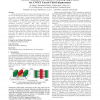13 search results - page 2 / 3 » Imperfection-immune VLSI logic circuits using Carbon Nanotub... |
DATE
2008
IEEE
13 years 11 months ago
2008
IEEE
Metallic Carbon Nanotubes (CNTs) create source-drain shorts in Carbon Nanotube Field Effect Transistors (CNFETs), causing excessive leakage, degraded noise margin and delay variat...
GLVLSI
2010
IEEE
13 years 6 months ago
2010
IEEE
This paper describes a physics-based semi-analytical model for Schottky-barrier carbon nanotube (CNT) and graphene nanoribbon (GNR) transistors. The model includes the treatment o...
DAC
2010
ACM
13 years 8 months ago
2010
ACM
Carbon Nanotubes (CNTs) are grown using chemical synthesis, and the exact positioning and chirality of CNTs are very difficult to control. As a result, “small-width” Carbon Na...
DATE
2010
IEEE
13 years 10 months ago
2010
IEEE
Carbon Nanotube Field-Effect Transistors (CNFETs) can potentially provide significant energy-delay-product benefits compared to silicon CMOS. However, CNFET circuits are subject t...
DATE
2010
IEEE
13 years 10 months ago
2010
IEEE
Ambipolar devices have been reported in many technologies, including carbon nanotube field effect transistors (CNTFETs). The ambipolarity can be in-field controlled with a secon...

